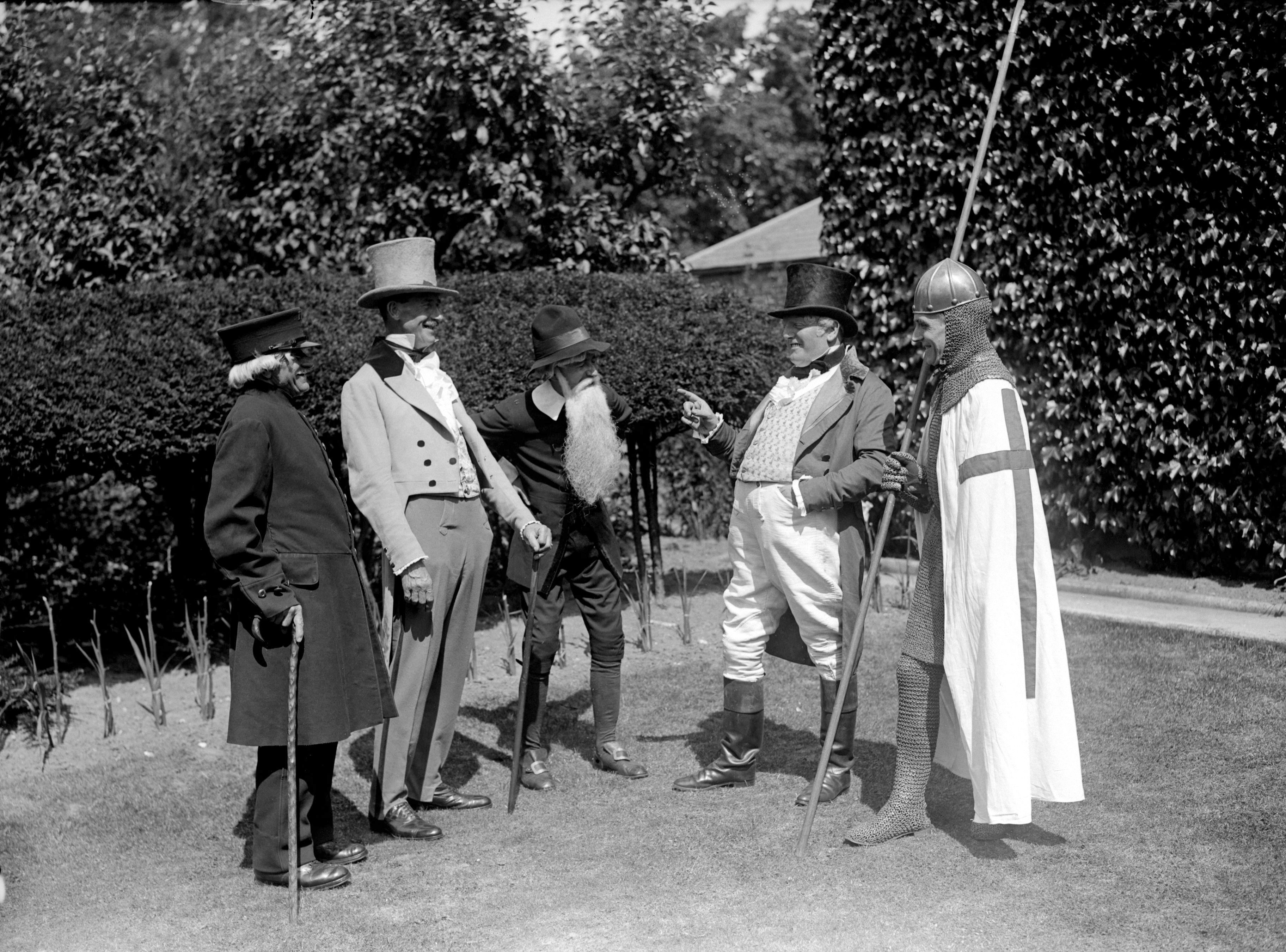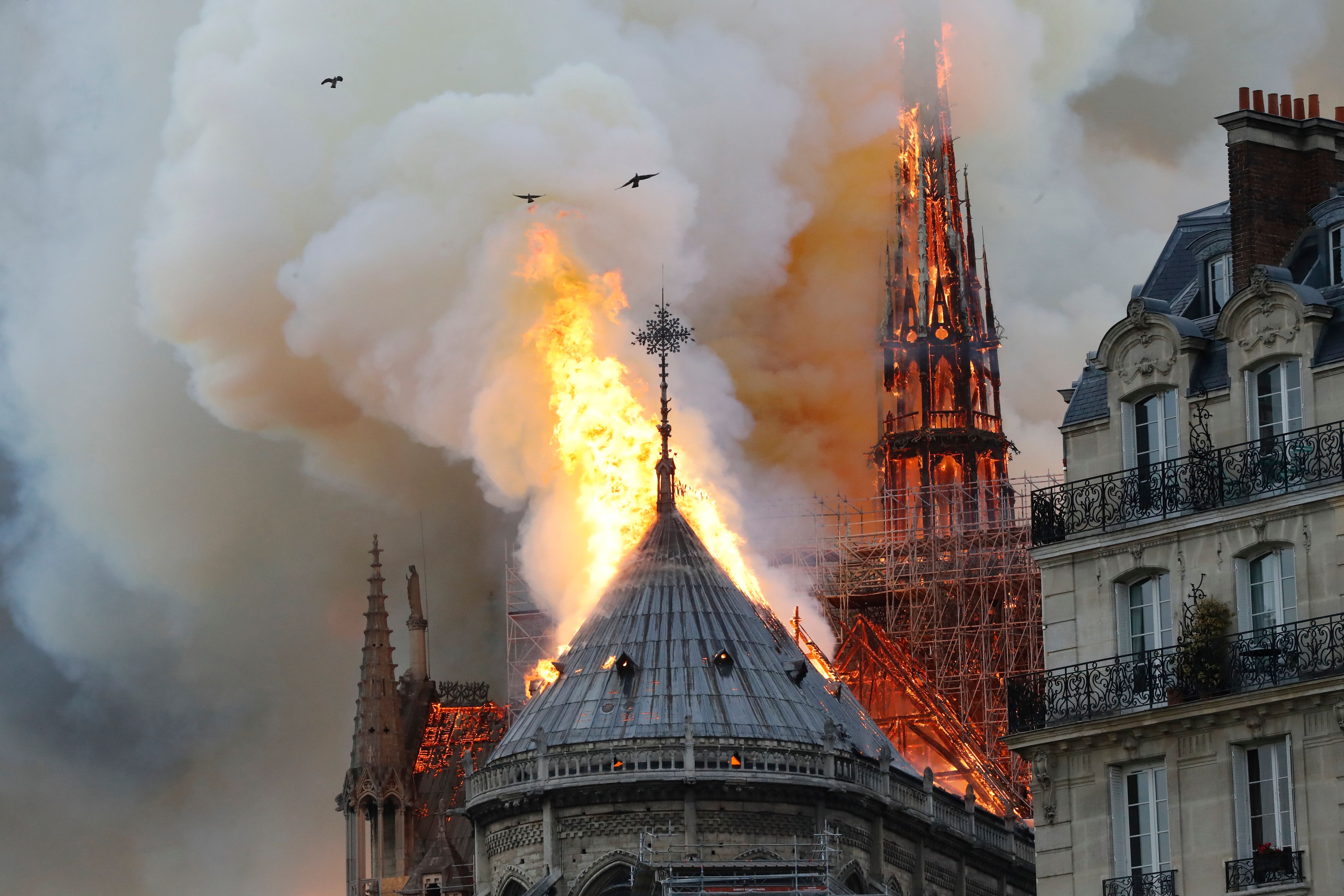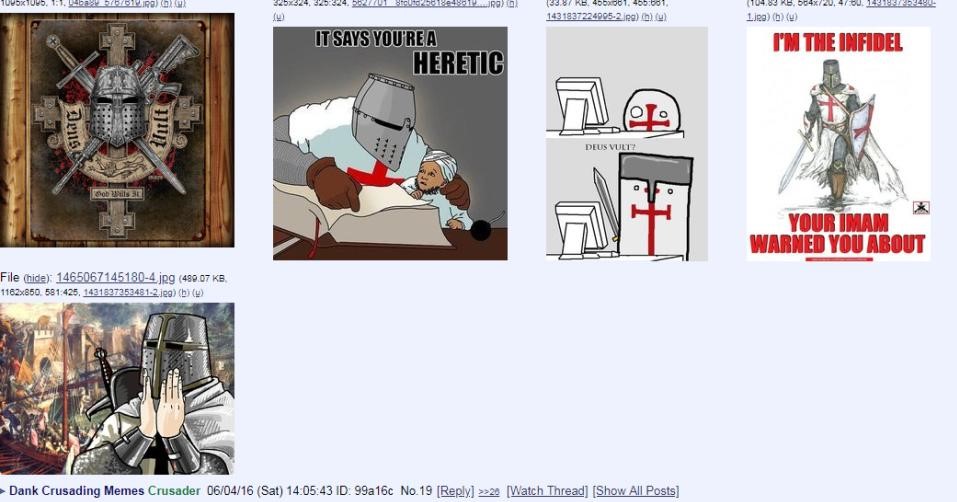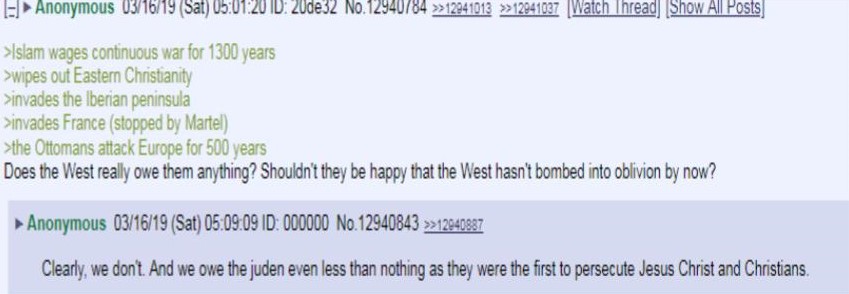This April, as I joined millions of people around the world watching towering flames consuming the roof of Notre Dame Cathedral, I mourned the destruction of something medieval and beautiful. I’ve spent my life studying the medieval church in all its human complexity, an institution capable of terror and bigotry, but also designed to promote faith through the brightness of beauty and learning. That history defies simple stereotypes.
Simple stereotypes about the Middle Ages, though, aren’t just wrong; they have become weapons for white supremacy. As the great spire of Notre Dame fell, I knew the disaster, whatever the cause turned out to be, would fuel incendiary anti-Muslim and anti-Jewish conspiracy theories based on white supremacist reconstructions of Western European history.
The discipline of medieval history, like all history, has always been political. For many scholars and fans of medievalism in fantasy or other genres (Renaissance festivals, architecture, European martial arts), this simple truth remains uncomfortable. As the New York Times recently reported, a large faction of academics—most of them white, in my experience—dismiss the notion that white supremacists’ use of the Middle Ages should influence how we teach and study the past. Such skeptics argue that these medievally minded murderers are a rarity—and moreover that these young men don’t know much about history. The bigots place medieval symbols next to Pepe the Frog memes or racist YouTube videos, thus (according to the skeptical faction) pulling the medieval content outside of time, creating an ahistorical iconography that historians need not bother about too much, beyond periodic fact-checking.
Consumers of medievalism in movies and games don’t have quite the same responsibility as scholars, but they’re much more numerous and often equally resistant to recognizing white supremacy in their communities. Many such fans, especially in the white male demographic, seem to believe they can “keep politics out” of medieval-themed video and role-playing games and fantasy books. Both groups just don’t want to complicate their engagement with (and enjoyment of) the medieval past by worrying about white supremacy.
Since the murder of Heather Heyer by a white supremacist in Charlottesville, Virginia, in August of 2017, I’ve been regularly watching discussion boards on 8chan and the neo-Nazi website Stormfront to better understand what I call “8chan Medievalism.” I wanted to examine how the worst people in the world talk about the Middle Ages within their own Internet safe spaces. What I’ve found is that the problem has gotten worse online, even as 8chan medievalism has shown up in the writings of mass-murdering terrorists and would-be terrorists.
At least in some circles, scholars of the Middle Ages are increasingly organized in their responses to white supremacy. Foremost among these circles is a collective called Medievalists of Color; the group maps the many ways that scholars have long politicized the study of the Middle Ages around notions of race and whiteness, as centuries of white and usually male historians asserted their own primacy in the formation of the modern world. In doing so, groups like Medievalists of Color push the majority-white field to be more intentional about how we confront racism and other forms of oppression in our teaching and writing.

(Photo: Fox Photos/Getty Images)
Dorothy Kim, of Brandeis University, has told me that if we allow the study of the Middle Ages to be a blank and seemingly de-politicized space, white supremacists can more easily project their fantasies onto the medieval past. In 2016, the year before Charlottesville, Sierra Lomuto of Macalester College warned medievalists that white supremacists were turning “to the Middle Ages to find a heritage for whiteness.” As Lomuto writes:
We have an ethical responsibility to ensure that the knowledge we create and disseminate about the medieval past is not weaponized against people of color and marginalized communities in our own contemporary world. If white nationalists want to corrupt Celtic iconography with their white supremacist ideologies, or find solace in a game whose currency is a fantasy of whiteness, we can’t stop them. But we can refuse to help them.
To refuse them help, we need to see how white supremacists operate across rhetorical modes. On 8chan and similar websites, racist jokes and disgusting memes overlap with explicit references to historical events and a seemingly genuine enthusiasm for medieval art, culture, and history. The challenge of 8chan medievalism is that it often doesn’t look that serious or that scary, until suddenly the terrorist shows up at a mosque or synagogue, ready to kill.

Think of the visible forms of online hate as a kind of iceberg. Most people only see the tip of something that’s actually much vaster. Below the surface, on the worst websites, hate spreads in the form of conspiracy theories, memes, rumor-mongering, and plausibly (or theoretically) deniable attempts to exhort others to violence. These messages cohere again and again around consistent themes such as declining white birth rates, Jewish control of finance and Hollywood, and a white supremacist analysis of history. As Notre Dame burned, white supremacists took glee in the symbolism that a burning church provided for them.
The tip of this hateful iceberg was bad enough, among commentators with major platforms. As news of the blaze began to spread, right-wing pundit Ben Shapiro quickly started praising Notre Dame as a monument to “Judeo-Christian” civilization—a loaded term that right-wing Jews like Shapiro use to exclude Islam from the Abrahamic tradition, and which right-wing Christians use to suggest that Jews were just God’s first draft. Glenn Beck appeared on his own television network to make the unfalsifiable claim that, “if this was started by Islamists, I don’t think you’ll find out about it.” Philippe Karsenty, a right-wing French media analyst and former elected official, soon claimed on Fox News that the blaze had been no accident (and was abruptly cut off by anchor Shepard Smith, to Smith’s credit).
Fake news accounts proliferated, alleging that the fire had been caused by terrorism, and some of those stories were pushed to the top of social media networks by algorithms. Most of the hate-mongering tweets blamed Muslims, but an emphatic subsection latched onto the fact that French President Emmanuel Macron once worked for the Rothschild bank, so that they could blame the fire on the Jews. And those were just the people willing to spread their hateful lies in public.

(Photo: Francois Guillot /AFP/Getty Images)
Over on Stormfront, the neo-Nazi discussion board, the tone of reaction to the fire was almost giddy. One poster declared, “Moslems [sic] are responsible for this attack on Christian Europe.” Another blamed Mossad, the Israeli intelligence agency. Talk quickly shifted toward renovation, as these Western chauvinists worried that the cathedral’s art would be replaced with multicultural images and lose its alleged cultural purity. One poster wrote, “I fear Christian iconography like Notre Dame will be lost over time, and simpler, less well built rubbish will replace it. We’re at a new dark [age] and Notre Damn [sic] could have [been a] beacon for the future.”
On 8chan, a less ideologically coherent website, an argument broke out between Christians who were eager to depict the burning of Notre Dame as evidence of cultural desecration of their history, and white supremacists who have preferred to adopt neo-pagan practices as a pre-Christian, non-semitic religion—one more suited to nationalism and conquest. One anonymous poster touted the construction of Notre Dame in 1163 as proof that whites did not owe their greatness to colonialism. Most posters were eager to blame Jews for “working a cross-generational scheme to ruin the icons of [Western] history and success.” An anonymous poster advocated the mass flaying and crucifixion of all Jews in retaliation for the fire.
Do these people believe what they’re saying? It can sometimes be hard to tell, but certainly some 8channers are being strategic in their messaging efforts. In the early hours of the fire, one poster recommended a number of scripts his compatriots could follow to exploit the reports that continued to emerge from Paris, writing: “We cannot let Notre Dame die in vain. We must use this tragedy as a sacrifice to resurrect White Identity. If Migrants/Antifa did it [the usefulness] is obvious.” If the blaze was an accident, he argued, you could claim that “This is what happens when national/racial identity is eroded.” If the event received insufficient media coverage, you could blame the Jews for suppressing reporting. If the event was sufficiently covered, you could say that “national and racial identity is legitimized,” by which the poster seems to mean that pious coverage of the fire would implicitly support arguments about the greatness of white French history.
Chilling in its flexibility, the anonymous writer’s almanac prepared its readers to manipulate any scenario.

(David M. Perry)
The online hate lurched between the terrifyingly serious, the casually bigoted, and the deliberately absurd. Among the common threads, though, were claims on the past: claims that Notre Dame stood in as an artifact of white history, a testament to Western greatness. This is the lure of 8chan medievalism.

The Notre Dame fire turned out to be an accident, and after a few days the lack of further news submerged the whole hate iceberg for a time. That doesn’t happen so quickly when manifestations of 8chan medievalism emerge following horrific acts of violence, including the murder of 49 worshippers at two mosques in Christchurch, New Zealand.
The Christchurch killer, Brenton Tarrant, hoped to inspire others to follow him, posting images of a rifle lavishly decorated with references to medieval and modern acts of violence, as well as a long ranting document intended to inspire further attacks and troll the media. The killer’s half-joking tone is no mistake, but rather a longstanding rhetorical method of white supremacy to plausibly deny their intended violence until they pull the trigger.
There’s no reason to share Tarrant’s document widely and give him the fame he so desired. It is important, though, to understand how his writings connect to a broader online conversation about the medieval past that was already happening before he picked up his rifle, and which continues to this day. All consumers of medieval history, culture, and its modern manifestations need to be aware of how 8chan medievalism manifests, so that they can recognize it in their classrooms, online communities, gaming groups, and even families.
Tarrant’s medievalism is most vividly embodied by his weapon, a black AR-15 style rifle that he decorated with references to modern anti-Muslim terrorists, and to two medieval battles: the battle of Tours, in 732 C.E., and the Battle of Vienna, in 1683. At the latter, a combined European army defeated the Ottoman forces in the Austrian capital. In the former, the Frankish ruler Charles Martel, whose name also appears on the rifle, fought against a Muslim raiding party heading into France from Iberia. It was a reasonably significant victory, but not one that Martel himself interpreted as a victory over Islam; rather, as historian James T. Palmer explains, Martel was simply a medieval lord defending his lands and rights. It took the 18th-century historian Edward Gibbon to construct the myth that, without Martel, everyone in Western Europe today would be speaking Arabic. It’s a myth that white supremacy has found useful ever since. It has leapt from the pages of one of the most famous historians of the imperial age to appear in textbooks everywhere, to 8chan chat sites, and then onto the weapon of a mass murderer.
Tarrant’s long and incoherent text emphasizes fears about declining white birth rates in comparison to those among non-white peoples, a racist commonplace that extends far beyond 8chan, to places like Fox News and the White House. The terrorist links his narrative of demographic competition to an imagined history of perpetual conflict between “Europeans” and Muslims. That imagined history, he argues, justifies contemporary hatred; and that’s where the medievalism comes in. Tarrant constructs a narrative of constant warfare between “Europeans” and Muslims invaders, focusing specifically on the Crusades. Here is another place where the links between seemingly respectable sources and white supremacy emerge.
At one point, for example, Tarrant inserts a weird English translation of the supposed speech that Pope Urban II delivered in 1095 to launch the First Crusade. It’s an important speech that exists in a number of well-documented variations; it’s unlikely that any of them were an authentic record of what the pope actually said. But then, authenticity isn’t Tarrant’s message; he just wants to grab some history that supports a call for what he imagines might become a new crusade.
The origin of the excerpt, though, is revealing. He’s pulled it from an English translation of a French translation of a Latin version of the speech. The content isn’t unusual: Leveraging versions of Pope Urban’s speech to call for modern violence against Muslims is a standard feature of crusading medievalism. But the peculiarities of the textual transmission allowed me to locate it on the website of a Catholic group called Tradition in Action. TIA purports to “defend the perennial Magisterium of Holy Mother Church and Catholic traditions.” (The site adds that “TIA also works for a restoration of Christian civilization, adapted to contemporary historical circumstances.”) The terrorist lifted his translation from one of many articles on the group’s website glorifying the Crusades. What happened, in short, is that a reasonably mainstream manifestation of conservative Catholicism posted a text that, in turn, fueled the ideology of a murderous terrorist ideology. (Requests for comment from Tradition in Action were not returned.)

(Photo: 8chan/David M. Perry)
Not all manifestations of medievalism draw from such seemingly respectable sources. Tarrant also clearly engaged with the glorifications of crusading violence that can be found all over 8chan. For example, there’s an entire forum dedicated to “dank crusader memes,” mostly featuring muscular cartoon Templars threatening Muslims . It’s also easy to see how these posters intensify each other’s bigotry, as they escalate the rhetoric and egg one another on. For example, a first person asserts that Islam is bad because it supposedly waged “continuous war” for 1,300 years, wiped out Eastern Christianity, invaded Iberia, and “invade[d] France (stopped by Martel).” A second poster replies that Muslims are therefore owed nothing by “the West,” and should just be happy not to have been “bombed into oblivion.” A third poster chimes in to agree with the second, adding, “And we owe the juden even less,” because Jews were the first to persecute Jesus Christ.

(Photo: 8chan/David M. Perry)
Even a casual search locates countless posts along these lines, fulminating against Jews and Muslims, crafting historical narratives to support hate, and trying to out-do each other with what the posters see as clever offensiveness. Is it any wonder that terrorists continue to emerge from these communities?

Hate is proliferating through virtual and physical spaces around the globe. In Poland, where the government has recently passed a law making it illegal to discuss Polish complicity in the Holocaust, Polish teens were photographed holding a replica of the Christchurch killer’s rifle. This April, a killer in California murdered a 60-year-old woman at her synagogue during Passover celebrations, wounded three others, and—like the Christchurch killer—posted a manifesto online. In it, he confessed to having set fire to a mosque, and said he’d been inspired to escalate his violence after the terrorism at the mosque in Christchurch and at the synagogue in Pittsburgh. He also cited the medieval myth of the blood libel, referring to Simon of Trent, a Christian child allegedly murdered by Jews in the 15th century.
The blood libel has resulted in the murders of Jews for almost six centuries. If you search Google for Simon of Trent, the second result is a virulently anti-Semitic site dedicated to spreading hate against Jews. At the bottom, it urges the reader to “share the page with another Catholic you know.” 8chan and Stormfront aren’t the only culprits here. The big Internet platforms like Google enable the white supremacy-curious to find models and escalate toward violence.
The college campus is one area where these histories and ideologies are energetically contested. A 2018 report from the Anti-Defamation League noted an unprecedented rise in white supremacist activity on American college campuses. A 2019 study by the American Association for Access, Equity, and Diversity found hate incidents on nearly every campus it surveyed, in some cases occurring with alarming frequency, with recent incidents in Tennessee, Michigan, and Florida.*
Imagine a student scouring the Internet for the latest meme, sitting through a history class, talking with friends about a fantasy book or computer game, then walking past a white supremacist flier or demonstration. Are they ready to encounter that kind of hate? Will they be drawn in? Will they become a vector to bring white supremacy to others?
White supremacist co-option of the Middle Ages is complicit in murder. Responding to deadly myths about the past requires the rigorous advancement of counter-narratives, coupled with the de-platforming of those who would infect others with their hateful ideology. Educators and students, gamers and authors, those of us who mourn the conflagration at a Paris cathedral—we all need to recognize the task at hand and then get to work.
*Update—June 27th, 2019: This post has been updated to reflect the three states that have experienced recent hate incidents.

Pacific Standard’s Ideas section is your destination for idea-driven features, voracious culture coverage, sharp opinion, and enlightening conversation. Help us shape our ongoing coverage by responding to a short reader survey.





